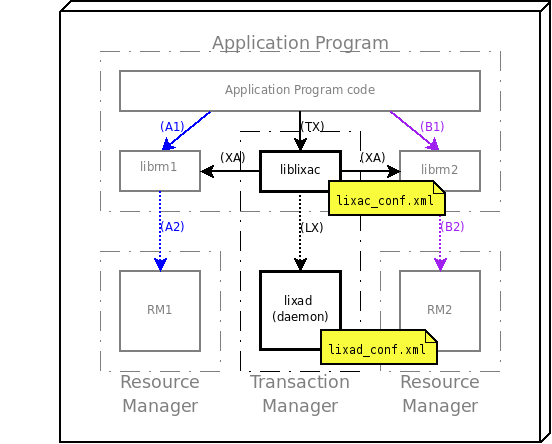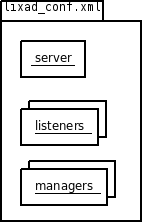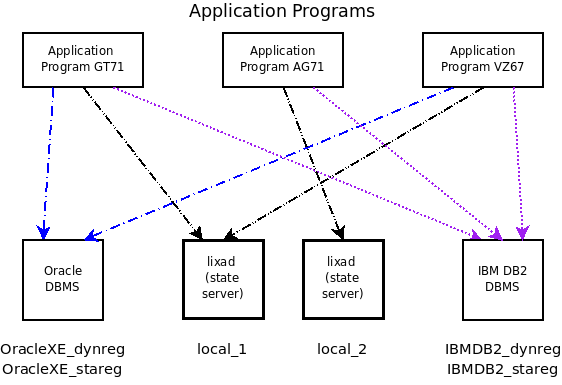The picture below emphasizes the LIXA components that must be configured in a simple scenario:
The client component (lixac)
is configured using the
etc/lixac_conf.xml file; the server component
(lixad) is configured using the
etc/lixad_conf.xml file
[17].
If a node hosts both the client and the server components, both the files must be configured. If a node hosts only one component, only one configuration file is necessary [18].
The default configuration file is
etc/lixad_conf.xml
and is located at the root installation path (i.e.
/opt/lixa/etc/lixad_conf.xml).
The file is composed of three sections:
the server section contains the global parameters of the server
the listeners section specifies how many TCP/IP addresses and ports must be listened to accept incoming client connections
the managers section specifies how many parallel threads must be activated to serve the LIXA clients
Below there is a sample configuration file:
<?xml version="1.0" encoding="UTF-8" ?>
<server
pid_file="/opt/lixa/var/run.pid"
min_elapsed_sync_time="0" max_elapsed_sync_time="0">
<listeners>
<listener domain="AF_INET" address="127.0.0.1" port="3456"/>
<listener domain="AF_INET" address="0.0.0.0" port="2345"/>
</listeners>
<managers>
<manager status_file="/opt/lixa/var/lixad_status1"/>
<manager status_file="/opt/lixa/var/lixad_status2"/>
<manager status_file="/opt/lixa/var/lixad_status3"/>
</managers>
</server>
The tags and the properties of the XML file are described below:
pid_file: it is the file used by the server to store the daemon PID; the server creates the file at start-up and destroys it at shutdownmin_elapsed_sync_time: minimum time expressed in millisecond interleaving a state file synchronization request and the start of the synchronization operation; every manager (thread) uses its own clockmax_elapsed_sync_time: maximum time expressed in millisecond interleaving a state file synchronization request and the start of the synchronization operation; every manager (thread) uses its own clock.max_elapsed_sync_timecan not be less thanmin_elapsed_sync_time; see Chapter 11, Tuning for more information about these parameters.listener: the server can activate one or more listeners; most of the times one listener is sufficient, but if you want to use only a subset of the IP addresses defined at the operating system level, you have to configure a dedicated listener for every desired addressdomain: the type of socket must be used to listen for clients. The only allowed type isAF_INET; this may change in the futureaddress: the address that must be used to listen for clients; the special value "0.0.0.0" means any addressport: the port that must be used to listen for clients; it must be a free port (use command netstat to find out one)manager: any configured manager is a server worker and runs as a dedicated thread. Refer to Chapter 11, Tuning for a discussion about configuration and performance resultsstatus_file: the physical path that must be used to create the status files (a couple) for a manager; this generally is a persistent and reliable storage device like a RAID partition. The string specified by the tagstatus_fileis used as a prefix: every manager (thread) creates two files with the same prefix and different suffixes.
Parameters
min_elapsed_sync_time and
max_elapsed_sync_time
have a great relevance with the performance of the LIXA system
as explained in Chapter 11, Tuning but they have a relevance
with system robustness as well:
the higher the delay between the time a client ask a disk
synchronization and the time the state server performs it
(min_elapsed_sync_time), the higher
the chance the disk status files will not contain the correct
state for some transactions if the state server crashes.
The risk is not related to data corruption: data integrity is guaranteed by the Resource Managers your Application Programs use. The risk is some “prepared/recovery pending” transactions will not automatically recovered (see the section called “Automatic recovery concepts”) by LIXA infrastructure; those transactions will need manual recovery (see the section called “Manual (cold) recovery”).
During the interval between state server crash and manual recovery your Resource Managers will keep some locks on data: this could be the real damage for your application.
The default configuration file is
etc/lixac_conf.xml
and is located at the root installation path (i.e.
/opt/lixa/etc/lixac_conf.xml).
The file is composed of three sections:
the state servers section contains a list of the available LIXA state servers and how they can be contacted
the resource managers section contains a list of the available Resource Managers and how they can be managed by LIXA using XA standard API and protocol
the profiles section contains a set of possibly different profiles: every Application Program can use only one profile; if you had different Application Programs with different requirements, you should create different profiles. Every profile contains a set of servers and a set of Resource Managers that must be used to support the Application Program.
Below there is a sample configuration file:
<?xml version="1.0" encoding="UTF-8" ?>
<client>
<sttsrvs>
<sttsrv name="local_1" domain="AF_INET" address="10.23.45.67" port="2345" />
<sttsrv name="local_2" domain="AF_INET" address="10.23.46.91" port="3456" />
</sttsrvs>
<rsrmgrs>
<rsrmgr name="OracleXE_dynreg" switch_file="/opt/lixa/lib/switch_oracle_dynreg.so" xa_open_info="Oracle_XA+Acc=P/hr/hr+SesTm=30+LogDir=/tmp+threads=true+DbgFl=7+Loose_Coupling=true" xa_close_info="" />
<rsrmgr name="OracleXE_stareg" switch_file="/opt/lixa/lib/switch_oracle_stareg.so" xa_open_info="Oracle_XA+Acc=P/hr/hr+SesTm=30+LogDir=/tmp+threads=true+DbgFl=7+Loose_Coupling=true" xa_close_info="" />
<rsrmgr name="IBMDB2_dynreg" switch_file="/opt/lixa/lib/switch_ibmdb2_dynreg.so" xa_open_info="axlib=/opt/lixa/lib/liblixac.so,db=sample,tpm=lixa" xa_close_info="" />
<rsrmgr name="IBMDB2_stareg" switch_file="/opt/lixa/lib/switch_ibmdb2_stareg.so" xa_open_info="axlib=/opt/lixa/lib/liblixac.so,db=sample,tpm=lixa" xa_close_info="" />
</rsrmgrs>
<profiles>
<profile name="GT71">
<sttsrvs>
<sttsrv>local_1</sttsrv>
</sttsrvs>
<rsrmgrs>
<rsrmgr>OracleXE_stareg</rsrmgr>
<rsrmgr>IBMDB2_stareg</rsrmgr>
</rsrmgrs>
</profile>
<profile name="VZ67">
<sttsrvs>
<sttsrv>local_1</sttsrv>
</sttsrvs>
<rsrmgrs>
<rsrmgr>OracleXE_dynreg</rsrmgr>
<rsrmgr>IBMDB2_dynreg</rsrmgr>
</rsrmgrs>
</profile>
<profile name="AG71">
<sttsrvs>
<sttsrv>local_2</sttsrv>
</sttsrvs>
<rsrmgrs>
<rsrmgr>IBMDB2_dynreg</rsrmgr>
</rsrmgrs>
</profile>
</profiles>
</client>
The tags and the properties of the XML file are described below:
sttsrv: this section is used to describe a state server (a LIXA server instance) that must be reached by any client described belowsttsrv/name: a name associated to the state server; it is a logical name that is referenced by the profiles defined belowdomain: it must be the same domain specified by the listener that must be reached; the listener is configured inlixad_conf.xml(see above) and may be local or remoteaddress: it must be the same same address specified by the listener that must be reached; the listener is configured inlixad_conf.xml(see above) and may be local or remoteport: it must be the same port specified by the listener that must be reached; the listener is configured inlixad_conf.xml(see above) and may be local or remotersrmgr: this section is used to describe a resource manager that will be used by the Application Programs configured below (see profiles)rsrmgr/name: a name associated to the Resource Manager; it is a logical name that is referenced by the profile defined belowswitch_file: name of the file that contains the XA switch structure; the file is produced by the installation procedurexa_open_info: it is the string of parameters that must be passed to the Resource Manager by the xa_open() function call; the content of the string depends on the Resource Manager, please refer to the documentation distributed with the resource manager you are using. The string can not exceed 255 charactersxa_close_info: it is the string of parameters that must be passed to the Resource Manager by the xa_close() function call; the content of the string depends on the Resource Manager, please refer to the documentation distributed with the resource manager you are using. The string can not exceed 255 charactersprofile: it contains the description of the LIXA every transactional profile must be used by the Application Programs needs to be listed hereprofile/name: the name associated to the transaction profile; this name is used in different places and it is suggested to avoid special characters, blanks and possibly mixed case (these hints may help you in troubleshooting)profile/sttsrv: the state server that will be used to store the transactional information associated to this profile; more than one state servers can be specified but only the first one is used with the current release softwareprofile/rsrmgr: every Resource Manager that must be used by the Application Programs associated to this transactional profile needs to be listed here. There is no a limit: you can specify 1, 2, 3, ... resource managers. Avoid useless resource manager because xa_open() and xa_close() will be performed against all the listed resource managers. If you can choose between a "dynamic" and a "static" version of the same resource manager, the "dynamic" one is more efficient
The client configuration file contains three sections:
sttsrvs: is the list of the LIXA daemons you are running inside your network and you will use to manage the persistent state of the clients that are using the configuration file; many times a single LIXA state server is sufficient, but sometimes you need more (development, test and production environment might use different LIXA servers)rsrmgrs: the list of the Resource Managers necessary execute the Application Programs; there is no limit to the number of resource managers you can specify from a LIXA point of view, but you should avoid to list useless Resource Managers to obtain the best performanceprofiles: the list of the available transactional profiles for your Application Programs. This concept allows you a great configuration flexibility: the same configuration file can be used for completely different Application Programs and completely different environment. As an example, imagine you have 3 distinct applications and every application uses a different mix of resource managers; then you manage 3 different environments (development, test and production): with 9 profiles you can model your transactional needs completely (APP1DEV, APP2DEV, APP3DEV, APP1TEST, APP2TEST, APP3TEST, APP1PROD, APP2PROD, APP3PROD).
The picture below models an environment that's using the sample
etc/lixac_conf.xml
showed above:
The scenario is composed of three distinct applications:
GT71: it's an application that uses both an Oracle and an IBM DB2 DBMS; most of the transactions need to perform distributed transaction processing and the profile specifies the static registration versions of the switch files.
AG71: it's an application that uses only an IBM DB2 DBMS; only few transactions need to perform distributed transaction processing and the profile specifies the dynamic registration versions of the switch files. This application does not need an XA Transaction Manager because it uses only one Resource Manager, but the development team decided to use LIXA because it will use a second Resource Manager in the next few months.
VZ67: it's an application that uses both an Oracle and an IBM DB2 DBMS; only few transactions need to perform distributed transaction processing and the profile specifies the dynamic registration versions of the switch files.
The scenario uses two distinct LIXA state servers: this is an unusual situation but it works.
The LIXA_PROFILE environment variable must be used
to specify the transactional profile associated to the Application
Program.
If you do not specify a valid transactional profile,
the first profile
of the list will be applied (in the above example it's
GT71).
Note
There is not an alternate way to specify the
transactional profile:
tx_open does not allow parameters.
With reference to scenario showed above, Application Program GT71
must export LIXA_PROFILE before execution; if
you are using bash shell you must specifiy
something like this
export LIXA_PROFILE=GT71
before application execution. The same applies to Application Program AG71 and VZ67:
export LIXA_PROFILE=AG71 [...] export LIXA_PROFILE=VZ67
If you change the content of lixac_conf.xml
you will change the signature associated to the configuration file
from LIXA Transaction Manager. The signature is very important
because LIXA Transaction Manager will not activate automatic
recovery of “prepared/recovery pending” transactions
if configuration file signatures do not match. In the case of
signature mismatch during automatic recovery, the LIXA system
reacts with some log messages as below:
Feb 8 21:38:51 ubuntu lixad[2517]: LXD011W a client is performing recovery but config file changed in the meantime for job 'a100c8728292168b21ba7239bffc137d/127.0.0.1 ' and transaction '1279875137.46d1df80428d4d6c85e6919b16b4a744.a100c8728292168b21ba7239bffc137d' Feb 8 21:38:51 ubuntu lixat[2532]: LXC001E transaction '1279875137.46d1df80428d4d6c85e6919b16b4a744.a100c8728292168b21ba7239bffc137d' can NOT be recovered because current config digest 'a100c8728292168b21ba7239bffc137d' does NOT match server stored config digest '9e4c11057107c73366c9fc421eaa85ca'
LIXA state server issues a warning (LXD011W) while LIXA Transaction Manager (client) issues an error (LXC001E): this behavior is necessary to protect the whole system against undesired recovery operation that could damage your data inside the Resource Managers.
This protection has a cost explained in the section called “Recoverying a transaction associated to a different job”.
Important
Before editing (and saving) lixac_conf.xml,
be sure there are no
“prepared/recovery pending” transactions
(you can use --dump as explained in
the section called “Dump execution” and in
the section called “Recoverying a “recovery failed” transaction”
to verify the content of the state server).
Create a different config file and use
LIXA_CONFIG_FILE environment variable
as explained in
the section called “Environment variables” until you are not sure
about the changes you are performing.



